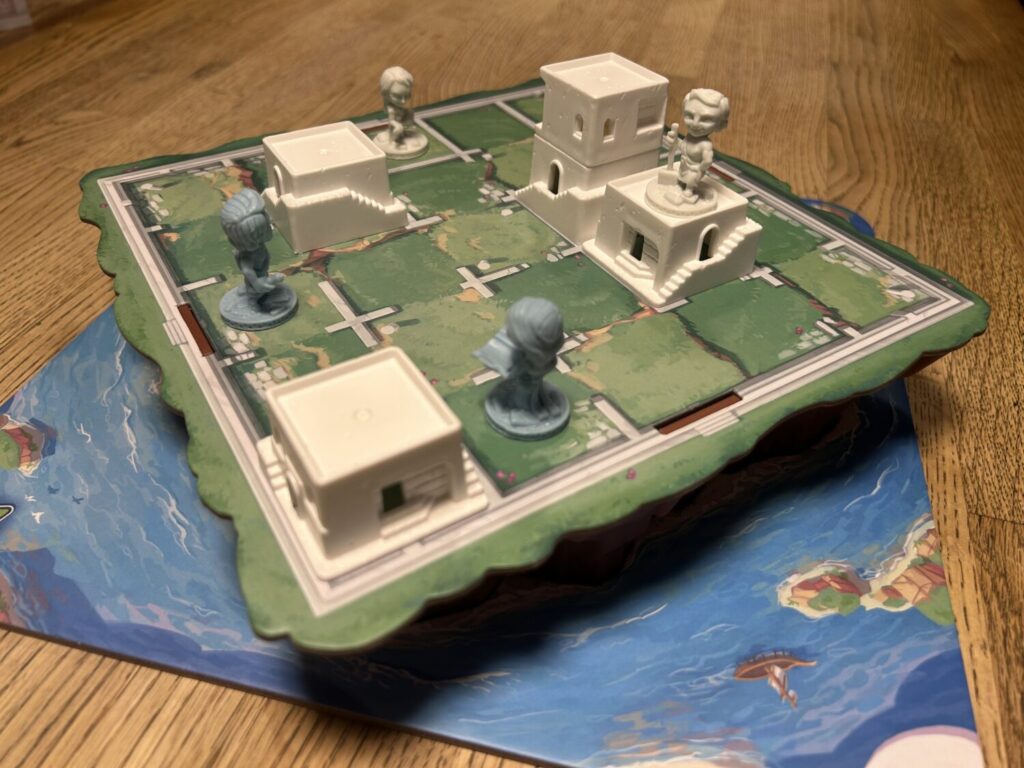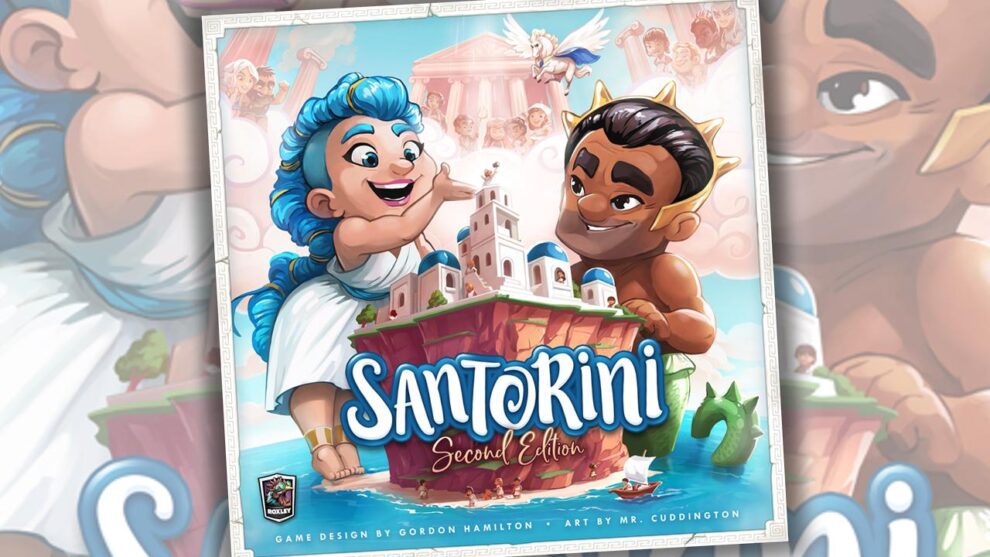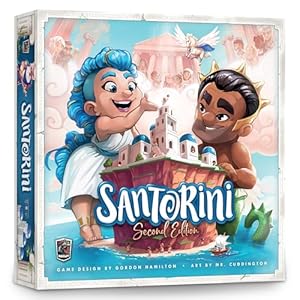Disclosure: Meeple Mountain received a free copy of this product in exchange for an honest, unbiased review. This review is not intended to be an endorsement.
I don’t know of many games that are more misleading than Santorini. That box, with its warm whites and cool blues. That beautiful and bold and fundamentally round art, the best Saturday morning cartoon that never existed. The spirited sculpts for the worker figurines, charming and full of life. Those building pieces, luminously white, peppered with the perfect amount of texture, of cracks and crevices, to say nothing of those beautifully contrasting blue domes. This is a masterclass in production design. Few games look as inviting as Santorini.
This soothing exterior, I want to be clear, is a lie. Santorini’s superlative presentation is a marvelous trap.

Up Ol’ Mount Olympus
Under the hood, Santorini is a diamond-cut abstract design, a collection of no more than five or six rules—if we are being real sticklers about what constitutes a discreet rule—that add up to a great game. Every turn is the same: move, then build. That’s all you do.
Within that simple recipe, there’s quite a bit to chew on. In one sense, Santorini is a race, an Olympic sprint to be the first player to reach the top floor of a three-story building. It’s also a punishing game of spatial relationships, as each player uses the restrictions on both movement and building to stymie their opponent’s plans. You thought you were going to win this turn? Don’t mind me, I’m just going to add a dome to the top of that building. Oh, did you want to build in the space where I just moved my worker? That’s too bad.
Part of what’s so great about Santorini is that this constant game of keep-away isn’t just a stall tactic; It’s a valid approach to victory. Rather than reaching the top floor of a building, you can also take home the laurel wreath by forcing your opponent’s pieces into positions where they no longer have any valid moves.
The end result of all this is a tense, quick, approachable game that rewards both long-term planning and short-term tactical flexibility. The joy of stepping on your opponent’s toes, and the agony of realizing you’ve just dropped a hammer on your own. A good abstract allows for players to express personality through their moves, and for those personalities to control the flow of the game. That’s very much the case in Santorini, even if you limit yourself to the basic form of the rules.

The Pantheon
Those basic rules will keep you entertained for dozens of plays, but if you feel like something is missing, you can always turn to the Gods. All the classics of the pantheon are here, Athena and Zeus and Hermes and Poseidon and so on and so forth. “God” is used loosely, to leave space for characters like Medusa and the Minotaur. There are 32 of these oversized, adorable deities included with the game, and there are dozens more available in the expansions.
Each provides its respective player with a power for the duration of the game. Artemis lets you move twice every turn. Demeter lets you build a second time. Workers for Zeus can build directly under themselves. Many of them are clever reflections of their bearers’ roles within mythology. If you decide to get really into Santorini, a perfectly reasonable thing to do in my opinion, it’s a lot of fun to figure out both how best to make use of your own power and, more interesting to me, how to play against whatever God your opponent has for this game. Each requires adjustments, and they interact with one another in interesting ways.
Hardened abstract players may balk at the powers. I get that. They aren’t necessarily balanced—with this many powers, frankly, they couldn’t be—but most matchups that initially seem lopsided are in fact invitations to make clever choices. This new edition includes some modifications to abilities that were previously too weak or too powerful, and several of the Gods include a note on the back of the card noting Gods against whom they should not be played. These changes help a good deal in evening things out.
Expandtheon
You will, frankly, never need more Gods. If you played Santorini every day for a year, you might reach a point where everyone feels a bit too familiar, but there are 900-ish different possible matchups in this box, and they all feel meaningfully different enough that they are worth exploring.
With that said, there are four expansions available—Tides of Poseidon, Soaring Over Olympus, Seasons of Chaos, and Hiding in the Underworld—and they are all worth exploring if you feel compelled. Some of these powers get, to use the technical term, nutty. I put those in approximate order of nuttiness, so dive in wherever you feel most comfortable. Just know that the nuttier the powers, the less Santorini retains the same abstract feel. If you want everything from the jump, you can pick up a copy of the Pantheon Edition, which is handsome.
But of course it’s handsome. It’s Santorini. Has any game ever managed to conceal such sharp corners beneath so much soft and squishy styrofoam? Root, maybe, but even Root is too involved to have the same obvious sharpness of Santorini. You sucker someone into playing by promising a cute and cuddly time, and before they realize something funny is going on, they’re thinking about openings. Santorini: Second Edition makes everything a little more beautiful, a little more balanced, just a little bit better. Open the box. Spring the trap. I promise, nobody will be upset.












